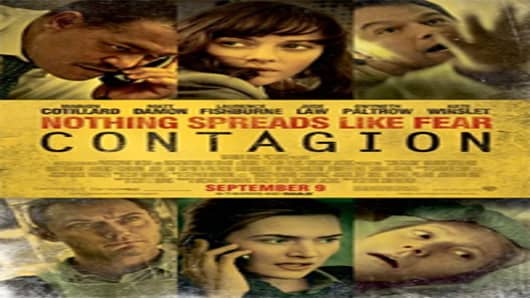I just returned from viewing Contagion.
Nearly every aspect of the science within the film was realistic, even the rapidity at which viruses can kill after one is exposed, and the existence of receptors on the respiratory cells that link up with the virus.
I did, however, question one thing about the scientific accuracy: the virus was said to mutate very quickly, which is fine and typical of viruses that use RNA as their genetic material. However, the activity of the human population seemed to bounce back very quickly in the film once a vaccine was found and administered.
If a virus mutates quickly, vaccines and other forms of prophylaxis can be rendered useless.
This is why finding solutions to combat HIV/AIDS has been so difficult; HIV is quite good at evolving and evading our efforts to control it. As for the overall impact of the virus on the human population, numbers used in Contagion (~26 million) were very realistic. Just for comparison, approximately 40 million people died from the Spanish flu (1918/1919), in fact, more soldiers died from the flu during World War I than they did from combat. Some have predicted that there will be 100 million deaths from the avian flu, if it ever takes hold in the human population.
The film’s description of how quickly the disease spread around the globe was certainly not exaggerated. In 2003, SARS spread from the Guongdong Province in China to many countries in very short order. Even in the 14th century, Black Death (the plague; a bacterial disease) moved relatively quickly by ship and by land to kill nearly 25% of the people in Europe.
I also believe Contagion conveyed the human response to the contagious disease fairly well, though at times the individuals seemed a bit too calm given the circumstances. The Department of Health and Human Services, including the Centers for Disease Control and Prevention (CDC), will need to play their cards carefully if we have a real Contagion (e.g., avian flu that is easily transmitted from human to human) in the future. A rapid spread of hysteria would seriously undermine efforts to control the disease.
Nevertheless, there are generally some positives you can take from even the most dire circumstances. Although the 14th century plague epidemic killed one out of every four individuals, it is believed that the Renaissance emerged because of it. Laborers were in such short supply that creativity and design (e.g., printing press) had to come to the rescue. What a 21st century pandemic would bring, only time will tell.
Alan B. Hale, Ph.D., Professor of Biology and Director of the Global Diseases Program at Cedar Crest College. His laboratory research is focused on the use of viruses in combating pathogenic bacteria, especially those that cause intestinal diseases in humans. He is currently teaching a course entitled, Outbreak Investigations: Case Studies in Epidemiology. Next spring he will be teaching two courses: Bioterrorism & Emerging Infectious Diseases and Multidisciplinary Solutions for Global Diseases.


